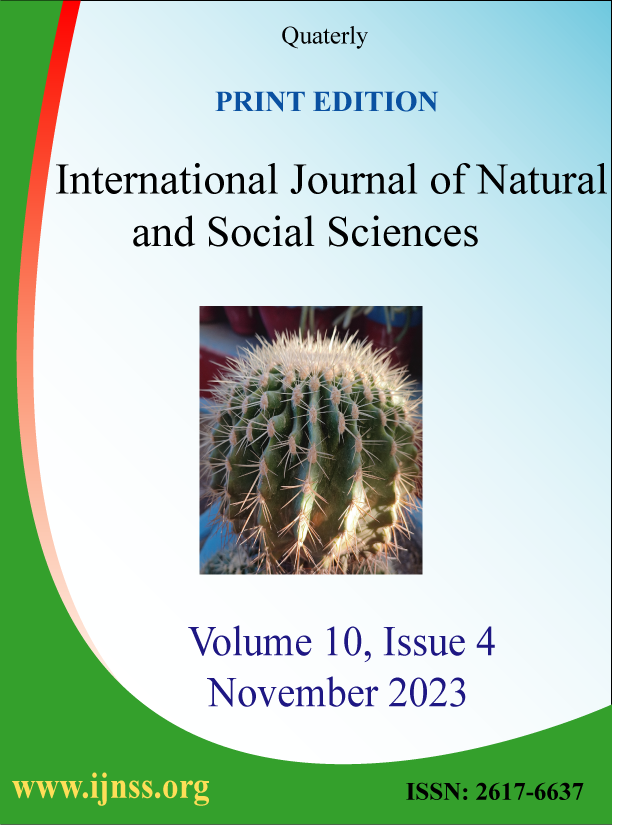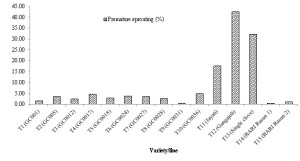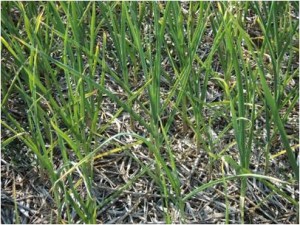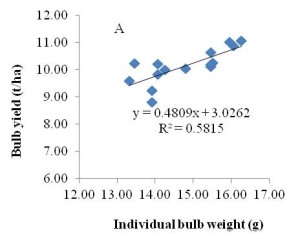Evaluation of some advanced garlic lines against premature sprouting under zero tillage mulched condition
Volume 2, Issue 1, February 2015, Pages 90–95
Md. Aminul Islam1![]()
![]() , Md. Robiul Alam1, Md. Maniruzzaman1, M. Shafiqul Islam1, Md. Samim Hossain Molla1, Mst. Anjumanara Begum2, Debashish Sarkar1 and Md. Rejaul Karim1
, Md. Robiul Alam1, Md. Maniruzzaman1, M. Shafiqul Islam1, Md. Samim Hossain Molla1, Mst. Anjumanara Begum2, Debashish Sarkar1 and Md. Rejaul Karim1
1On Farm Research Division, Bangladesh Agricultural Research Institute, Agricultural Research Station, Pabna, Bangladesh
2Department of Agronomy, Bangladesh Agricultural University, Mymensingh-2202, Bangladesh
| ABSTRACT | Get Full Text PDF |
The experiment was conducted in Bayoikhola village under multi location testing (MLT) site, Atghoria, Pabna during Rabi season to assess the performance of different advanced lines of garlic against premature sprouting under zero tillage mulched condition. Thirteen garlic lines viz. T1 (GC001), T2 (GC005), T3 (GC0012), T4 (GC0017), T5 (GC0018), T6 (GC0024), T7 (GC0027), T8 (GC0028), T9 (GC0031), T10 (GC0036), T11 (Jayati), T12 (Gangajoli) and T13 (single clove) along with two varieties T14 (BARI Rasun 1) and T15 (BARI Rasun 2) were used as test materials for the experimentation. Highest premature spouting was found in T12 (Gangajali, 42.50%) followed by T13 (single clove, 32.15%) and T11 (Jayati, 17.66%) where as the minimum was recorded from T9 (GC0031, 0.07%) that was statistically identical to rest of the lines and varieties. All the tested varieties and lines except T9 (GC0031) showed significantly higher and identical bulb yield. Numerically higher bulb yield (11.07 t ha-1) was recorded from T15 (BARI Rasun 2) followed by T14 (BARI Rasun 1) and the minimum (8.821 t ha-1) from T9 (GC0031). Regarding cost and return analysis, T15 (BARI Rasun 2) resulted in relatively higher gross return (498150Tk ha-1) that contributed to the highest net return (305096 Tk ha-1) against the total cost of Tk 193054 ha-1 followed by T14 (BARI Rasun 1) with a net return (303296 Tk ha– 1). Lowest yield was observed (203846 Tk ha-1) in T9 (GC0031). According to the research study as well as farmers observation, garlic production under zero tillage mulched condition seems to be more profitable as well as a resource conserving technology (saves water, time, pesticidal use) as it incurs higher yields with less production costs than conventional practice.
Key words: Garlic lines, premature sprouting, mulched condition, zero tillage.
![]() Corresponding author. Tel.: +8801722788312
Corresponding author. Tel.: +8801722788312
E-mail address: amin_bau@yahoo.com (MA Islam)
How to cite this article: MA Islam, MR Alam, M Maniruzzaman, MS Molla, MS Islam, MA Begum and D Sarkar (2015). Evaluation of some advanced garlic lines against premature sprouting under zero tillage mulched condition. International Journal of Natural and Social Sciences, 2(1): 90-95.
INTRODUCTION
Garlic (Allium sativum L.) belonging to the family Alliaceae (Kurian, 1995) is one of the important spices crops grown in the winter season (Rahim, 1988). It is second most used condiment in Bangladesh after onion. In spite of using as spices with food, powder, oil and a kind of salt produced from garlic are also being used in pharmaceuticals as popular remedy for various ailments and physiological disorders. Report claims that aqueous extract (containing allicin and related disulphides) of garlic reduces bad cholesterol (LDL cholesterol) from blood (Augusti, 1977). It can also be used for preparing pickles. Garlic acts as natural pesticides and has some sorts of role for controlling pests (Ghosh and Abdurahiman, 1985).
In Bangladesh garlic is produced in total area of approximately 42015 ha with a total production of 209153 tones (BBS, 2011). Despite such a production figure, a large quantity (about 20%) is imported every year at the cost of huge amount of foreign currency. In 2010-11 fiscal year, Bangladesh spent an amount of 3872.24 million taka to import an estimated amount of 34316.24 tones garlic from abroad. However, out of total cultivating area and production, greater Chalon Beel areas of Pabna, Natore and Sirajganj districts cover 10-12% area and 8-12% production. On the contrary, the average yields only 4.98 t ha-1 which is very low even as compared to some other developing counties like India. Cultivation of inferior genotypes with traditional production practices and premature sprouting are considered to be the main causes for low yield. Premature sprouting is a major physiological disorder mainly occurs under excess soil moisture condition at early stage especially when the bulbs are going to be matured. It shortens the shelf life as well as reduces quality of bulbs. However the incidence varies from variety to variety coupled with crop management practices as well. Garlic production under zero tillage mulched condition opens a new paradigm of agriculture in this territory and has become a cost saving potential resource conserving technology for boosting yield and economic return to the farmers. Zero tillage production system with mulching slows down the rate of soil moisture loss and increases soil microbial activity by covering the surface soils. Mondal et al., (2007) reported that tillage systems coupled with mulching play an important role in conserving soil moisture at different depth. Therefore, developments of high yielding varieties, appropriate management practices, production of quality bulb are some important factors to minimize the existing wide gap between production and consumption. For these consequences, the experiment was undertaken to evaluate field performances of some advanced garlic lines and thereafter select high yielding lines or varieties resistant against premature sprouting.
MATERIALS AND METHODS
Experimental site
The experiment was conducted at farmers’ field in Bayoikhola village (2407′24.61″N and 89013′51.85″E) under multi location testing (MLT) site, Atghoria, Pabna during the Rabi season in the year 2013-14. The experimental plot was characterized by medium low land and clay textured soil belongs to High Ganges River Flood Plain (AEZ 11).
Materials and experimental design
Thirteen advanced lines of garlic viz. T1 (GC001), T2 (GC005), T3 (GC0012), T4 (GC0017), T5 (GC0018), T6 (GC0024), T7 (GC0027), T8 (GC0028, T9 (GC0031),T10 (GC0036), T11 (Jayati), T12 (Gangajoli) and T13 (Single clove) along with two varieties T14 (BARI Rasun 1) and T15 (BARI Rasun 2) were used for the experimentation. The unit plot size was 1.5m x 1.2m. The experiment was laid out in randomized complete block (RCB) design with three replications.
Field and crop management
After recession of flood water from the experimental field, the plot retains sufficient moisture within a couple of days. In such soil moisture condition, separated healthy cloves of the tested lines and varieties were planted in experimental plot under no tillage condition on 21 November, 2013 maintaining 15 cm row to row and 10 cm plant to plant spacing. After planting of cloves, rice straw mulches were placed homogenously over the planted plot to enshroud the garlic cloves. The fields were fertilized with 160-52-125-25-3 Kg ha-1 N-P-K-S-B, respectively. The entire amount of all fertilizers except urea was broadcasted in the saturated soil of the plot before planting of cloves. Half amount of urea was applied as basal and the remaining half was applied in two equal splits immediately after first and second irrigation. Weeding’s were done two times to keep the land weed free. After visualizing the preliminary symptom of Purple blotch and Thrips infestation Rovral 50 WP @ 2 g L-1 and Malathion 57 EC @ 2 ml L-1 were applied three times with 7-10 days interval to control the disease and pest. Other management practices were done when necessary. The crops were harvested on 27 April, 2014 (Picture 1).
Data collection and statistical analysis
Data on yield and yield contributing parameters were measured at the maturity stage. Data on premature sprouting was recorded upon counting of sprouted bulbs at premature stage of crops. Collected data were analyzed using analysis of variance with the help of MSTATC software (version 1.2; Michigan State Universty; MI, USA). The significant differences between treatment means were compared by Duncan’s multiple range test at 5% level of probability as out lined by Gomez and Gomez (1984).
Figure 1
Premature sprouting (%) observed in different varieties/lines.
RESULTS AND DISCUSSION
The response of yield and yield contributing characters and premature sprouting of the tested materials of garlic under zero tillage mulching are presented in the table 1. All the parameters varied significantly except bulb diameter of garlic. The highest plant height (76.27 cm) was obtained from T10 which was identical with the remaining lines and varieties except T1, T2, T12 and T7. The lowest plant height (49.23 cm) was observed in T1, T2 and T12. All the tested materials showed significantly higher plant population except T8. Individual bulb weight followed more or less similar pattern as investigated in plant population except T11 and T12 which exhibited relatively lower individual bulb weight. Bulb diameter did not show significant variation and ranged from 2.92-3.56 cm. The highest no of cloves plant-1 (23.43) was obtained from T15 whereas T11 produced the lowest in number (15.37). Satisfactory bulb yield was achieved from all the tested lines and varieties under zero tillage mulched condition than the conventional practice (8.21 tha-1) not studied but surveyed from 20 farmers. More or less identical bulb yield was observed in all the cases. Maximum bulb yield (11.07 t ha-1) was achieved from T15 followed by T14 and the minimum (8.82 t ha-1) from T9. This might be due to minimum individual bulb weight coupled with bulb diameter resulted lower yield in T9. Garlic is a shallow rooted plant and responds well with continuous moisture supply to the soil. Moisture scarcity especially at vegetative stage results in stunting growth and lower yield. Sowing garlic cloves in muddy soils just after harvest of T. Aman rice and there after covering with mulch materials facilitated less weed infestation and conserved soil moisture properly. The results favoured the findings of many scientists (Lampurlanes et al., 2002; Arya, 2000; Akter et al., 2005 and Kabir et al., 2011).
Picture 1
Garlic production under zero tillage mulched condition.
Table 1
Yield and yield attributes along with premature sprouting of different advanced lines and varieties of garlic under zero tillage mulched condition.
| Treatments | Plant height (cm) | Plant population m-2 | Individual bulb weight (g) | Bulb diameter (cm) | No. of cloves plant-1 | Bulb yield(t ha-1) | Bulb yield (t ha-1) in conventional practice (surveyed) |
| T1 (GC001) | 49.23 c | 65.67 ab | 14.07 ab | 3.33 | 16.47 fgh | 9.84 ab | 8.21(20 farmers’ average) |
| T2 (GC005) | 50.77 c | 66.67 ab | 14.80 ab | 3.25 | 16.37 fgh | 10.04 ab | |
| T3 (GC0012) | 70.10 ab | 70.67 ab | 15.47 ab | 3.33 | 17.77 c-f | 10.64 ab | |
| T4 (GC0017) | 67.93 ab | 66.00 ab | 15.53 ab | 3.33 | 18.73 b-e | 10.27 ab | |
| T5 (GC0018) | 69.80 ab | 68.67 ab | 13.93 ab | 3.10 | 17.17 efg | 9.23 ab | |
| T6 (GC0024) | 72.17 ab | 66.00 ab | 15.47 ab | 3.33 | 15.87 gh | 10.11 ab | |
| T7 (GC0027) | 67.13 b | 67.33 ab | 14.27 ab | 3.28 | 19.33 bc | 10.01 ab | |
| T8 (GC0028) | 68.40 ab | 63.67 b | 15.47 ab | 3.33 | 17.70 c-f | 10.20 ab | |
| T9 (GC0031) | 68.00 ab | 70.67 ab | 13.93 ab | 3.19 | 17.63 def | 8.82 b | |
| T10 (GC0036) | 76.27 a | 68.00 ab | 16.07 a | 3.56 | 19.10 bcd | 10.89 ab | |
| T11 (Jayati) | 69.80 ab | 73.33 ab | 13.33 b | 2.93 | 15.37 h | 9.59 ab | |
| T12 (Gangajoli) | 56.90 c | 75.33 a | 13.47 b | 3.01 | 17.40 efg | 10.25 ab | |
| T13 (Single clove) | 67.63 ab | 73.00 ab | 14.07 ab | 3.27 | 17.23 efg | 10.22 ab | |
| T14 (BARI Rasun 1) | 68.17 ab | 67.00 ab | 15.97 a | 3.24 | 23.43 a | 11.03 a | |
| T15 (BARI Rasun 2) | 69.27 ab | 67.67 ab | 16.27 a | 3.45 | 20.13 b | 11.07 a | |
| CV (%) | 6.98 | 7.55 | 8.24 | 9.95 | 4.93 | 10.43 | – |
Means followed by same letter(s) do not differ significantly at 5% level.
Table 2
Cost and return analysis of different advanced lines and varieties of garlic under zero tillage mulched conditio
| Treatments | Gross return(Tk ha-1) | Total cost(Variable cost+Fixed cost)(Tk ha-1) | Net return(Tk ha-1) | BCR |
| T1 (GC001) | 442800 | 193054 | 249746 | 1.29 |
| T2 (GC005) | 451800 | 193054 | 258746 | 1.34 |
| T3 (GC0012) | 478800 | 193054 | 285746 | 1.48 |
| T4 (GC0017) | 462150 | 193054 | 269096 | 1.39 |
| T5 (GC0018) | 415350 | 193054 | 222296 | 1.15 |
| T6 (GC0024) | 454950 | 193054 | 261896 | 1.36 |
| T7 (GC0027) | 450450 | 193054 | 257396 | 1.33 |
| T8 (GC0028) | 459000 | 193054 | 265946 | 1.38 |
| T9 (GC0031) | 396900 | 193054 | 203846 | 1.06 |
| T10 (GC0036) | 490050 | 193054 | 296996 | 1.54 |
| T11 (Jayati) | 431550 | 193054 | 238496 | 1.24 |
| T12 (Gangajoli) | 461250 | 193054 | 268196 | 1.39 |
| T13 (Single clove) | 459900 | 193054 | 266846 | 1.38 |
| T14 (BARI Rasun 1) | 496350 | 193054 | 303296 | 1.57 |
| T15 (BARI Rasun 2) | 498150 | 193054 | 305096 | 1.58 |
| Conventional practice (20 farmers’ average) | 369450 | 201000 | 168450 | 0.83 |
Bulb price: 45 Tk kg-1, Total cost: Input cost (seed, fertilizer, labour etc) and fixed cost (land lease)
Premature sprouting was found in all the lines as well as varieties with a range from 0.473% in T9 to 4.85% in T10 except T11, T13 and T12. Maximum premature sprouting was found in T12 (42.50%) followed by T13 (32.15%) and T11 produced about 17.66% sprouted bulb in the same environment under zero tillage mulched condition (Figure1). Though, premature sprouting under conventional practice was not studied here but farmers claimed that a considerable number of bulbs went for sprouting before harvest when irrigation was applied at the later stage of bulbs development. However, according to farmers opinion prevalence of premature sprouting (data not included here) was varied with cultivars under conventional systems at on-farm levels.
Relationship between parameters
It was generally found that there was a positive relationship between the observed parameters shown in figure 2. However, bulb diameter and bulb yield showed relatively strong positive relationship with individual bulb weight. This result indicates that increment of individual bulb weight results in higher bulb diameter and bulb yield (Figure 2A and Figure 2B). The poor positive relationship was observed between no of cloves bulb-1 and bulb diameter (Figure 2C).

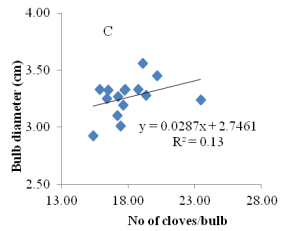
Figure 2
Relationship of individual bulb weight with bulb yield and bulb diameter (A and B), No of cloves bulb-1 and bulb diameter (C).
Financial analysis
Cost and return analysis presented in the table 2. The financial figures presented here were calculated apparently and may rise and fall with the fluctuation of market price of inputs and output over time. Among the lines and varieties, T15 provided highest gross return (498150Tk ha-1) and net return (305096Tk ha-1) against an estimated total cost of Tk 193054 ha-1 followed by T14. T9 exhibited poor performance due to lower yield potentiality. Maximum benefit cost ratio (BCR, 1.58) was recorded from T15 which was chased by T14 and the minimum (1.06) from T9. Conventional practice was seen less profitable regarding cost benefit analysis as gross return (369450), net return (201000) and BCR (0.83) were lower than that of zero tillage mulched condition probably tillage operation, additional irrigation and use of more pesticide put an extra cost to the farmers that triggered to the higher production cost in conventional practice.
CONCLUSION
Cultivation of inferior genotypes with traditional production practices are considered to be the main causes for low yield in Bangladesh. Many studies report that premature sprouting deteriorates the storage quality of garlic bulbs. All the accessions showed higher productivity with satisfactory economic return under no tillage mulched condition. They also performed better against premature sprouting except Jayati, Gangajoli and Single clove. Although the accessions showed optimistic results under zero tillage mulched condition, further study on irrigation scheduling is needed to investigate the effect of soil moisture especially at the later stage on premature sprouting of garlic under different tillage systems.
REFERENCES
Akter I, Rahim MA, Islam J, Rashid MA, Ara R, Hasan K, Alam MM, Islam MA, Alam MS, Haque MM, Haque MI, Moniruzzaman M, Mamum ANM, Khan MA, Bramma S, Ahmed MM, Anwar HRM and Alam MS (2005). Mashla Phosholer Utpadan Poddhati. Spice Resesrch Centre, BARI, Shibgonj, Bogra. 34 p
Augusti KT (1977). Hypocholesterolaemic effect of garlic (Allium sativum L.). Indian Journal of Experimental Biology, 15(6): 489-490.
Arya PS (2000). Spice Crops of India. Kalyani Publishers; 10/23, Ramanath Mazumdar Street, Calcutta. 700009. 327 p.
Gomez KA and Gomez AA (1984). Statistical Procedure for Agricultural Research. John Wiely and Sons. Inc. New York. Pp. 67-215.
Ghosh, SM and Abdurahiman, UC, 1985, On Some Hyperparasites of Opisina arenosella The Black-Headed Caterpillar Pest of Coconut in Malabar, India. Cocos, 3,29-31.
Gudi N, Swandi A and Hilman Y (1988). The effects of the application of stable manure and different trace to elements on garlic. Buletin Penelitian, Indonesia, 16(4): 5-13.
Kabir MA, Rahim MA and Majumder DAN (2011). Effect of organic manure on the growth and yield of garlic under zero tillage condition. J of Agroforestry and Environ 5 (1): 139-142.
Kurian JC (1995). Plant that Heal (1st edn.), Oriental Watchman publishing House, Punj., India. P31.
Lampurlanes J, Angas P and Martinez CC (2002). Root growth, soil water content and yield of barley under different tillage systems on two soils in semiarid conditions. Department de produccio Vegetal I Ciencia,Forestal,University de Lleida -IRTA,Rovira Roure 177, 25198 Lleida,Spain.16p
Mondal NA, Hossain SMA, Bhuiya SU and Jahiruddin M (2007). Tillage and mulch effects on soil environment, growth and yield of rainfed barley. Annals of Bangladesh agriculture,11(2): 33-44.
Rahim MA (1988). Control of growth and bulbing of garlic (Allium sativum L.). Ph D. Thesis, University of London. P. 203.
